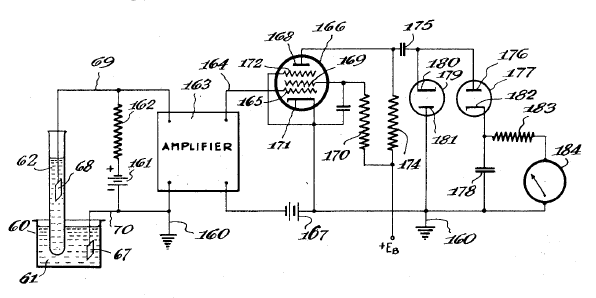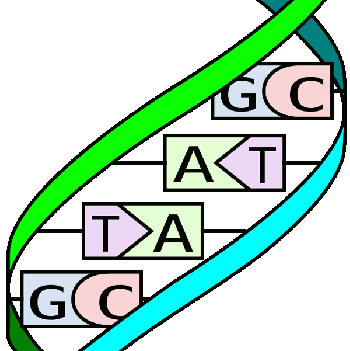| Tikalon Blog is now in archive mode.
An easily printed and saved version of this article, and a link
to a directory of all articles, can be found below: |
|
This article |
| Directory of all articles |
DNA Analysis
September 17, 2010
Anyone who's seen the results of a
blood test is likely amazed by the data for the CBC, or "
Complete Blood Count." A CBC is a volume percentage enumeration of the
many types of cells that comprise human blood. In the distant past, such counting was done by a technician peering through a microscope, since each type of cell has its own particular size. All that changed when electrical engineer,
Wallace Coulter invented the
Coulter counter.[1] The Coulter counter was a method of electrically classifying particles suspended in a conductive solution using a simple trick. Taking the example of blood, a dilute mixture of blood in an
isotonic solution is flowed from one reservoir to another through a thin tube. The solution is
electrically conductive, so there's a current flow between electrodes in the two reservoirs. When a blood cell enters the tube, the current is reduced, and the reduction depends on the size of the cell. Nowadays, with computers, binning of the currents, and the subsequent classification and counting of the cells, is easy. Things were somewhat primitive in Coulter's
vacuum tube days, as shown in the figure.

Figure seven of US Patent No. 2,656,508 (From Ref. 1).
Now that blood tests are a routine
medical diagnostic tool, scientists and engineers are struggling to go to the next step; namely, routine analysis of an individual's
DNA. Blood contains just a few cell types, and human DNA is built from just four
base pairs, so how hard can this be? The problem is that the
human genome has more than three billion DNA base pairs. If we can distinguish between the bases, we would still need to do this three billion times in a reasonable internal of time.
The
Human Genome Project, which was active from 1990-2003, used chemical techniques that were in common use at the time and a lot of computer manipulation to find the sequence of chemical base pairs in a representative sampling of DNA. The Human Genome Project cost about three billion dollars, although not all of the money was used for sequencing DNA. Genetics Pioneer
James D. Watson had his genome sequenced by advanced chemical techniques in 2007 for less than a million dollars in two months.[3] The price for a personal genome analysis is coming down to $100,000, and there's a goal for such chemical techniques to achieve a $10,000 personal genome. For comparison purposes, the cost of a CBC is less than fifty dollars. Any real progress in this area must come from non-chemical techniques.
There's research going back to the 1990s on using
scanning tunneling microscopic molecular imaging to analyze DNA.[2] The idea here is that you stretch a DNA strand between two points on a flat substrate and "image" each base pair as you scan along. The technique works, but it's too slow to be practical. Now, researchers from the Department of Materials Science and Engineering and the Department of Electrical Engineering and Computer Science,
Massachusetts Institute of Technology, and
Harvard University's Department of Physics, School of Engineering and Applied Sciences, and Department of Molecular and Cellular Biology, have looked to today's wonder material,
graphene, as a way to rapidly sequence DNA.[4-6] Graphene, which is an atomically-thin sheet of
graphite, is highly conducting in its plane, but it
insulates the regions on opposite sides of the sheet. Taking a cue from the Coulter counter, these researchers used
electron beams to drill nanometer holes in graphene sheets that separated solutions on opposite sides of the sheets. Solution ions in these holes affect the sheet conductivity of the graphene. DNA threaded through the holes displaces these ions to change the sheet conductivity of the graphene.

Just four base pairs... ...but three billion of them - The human genome.
The graphene was stretched over a
silicon frame, and an electrical potential applied from one solution to the other caused ions to flow through the nanopore, pulling the DNA strand through with it. Fortunately, graphene has the mechanical strength to resist breakage under these conditions. This work is a superb extension of the nanopore DNA analysis that's taken place at Harvard over the past decade.[7]
![]()
References:
- Wallace H. Coulter, "Means For Counting Particles Suspended In A Fluid," US patent No. 2,656,508 (October 20, 1953).
- D. Dunlop, "Scanning tunneling microscopy of DNA," Engineering in Medicine and Biology Magazine, vol. 15, no. 1, pp. 46-50.
- Nicholas Wade, "Genome of DNA Pioneer Is Deciphered," New York Times, May 31, 2007.
- Michael Patrick Rutter, "Graphene may hold key to speeding up DNA sequencing," Harvard University Press Release, September 9, 2010.
- Hagan Bayley, "DNA sequencing: enter the graphene nanopore," Nature, vol. 467, no. 7312 (September 9, 2010), p. 164.
- S. Garaj, W. Hubbard, A. Reina, J. Kong, D. Branton and J. A. Golovchenko, "Graphene as a subnanometre trans-electrode membrane," Nature, vol. 467, no. 7312 (September 9, 2010), pp. 190-193.
- Amit Meller, Lucas Nivon, Eric Brandin, Jene Golovchenko, and Daniel Branton, "Rapid nanopore discrimination between single polynucleotide molecules," Proc. Natl. Acad. Sci., vol. 97, no. 3 (February 1, 2000), pp. 1079-1084.
Permanent Link to this article
Linked Keywords: Complete Blood Count; Hematology; Wallace Coulter; Coulter counter; isotonic solution; electrically conductive; vacuum tube; US Patent No. 2,656,508; medical diagnostic; DNA; base pairs; human genome; Human Genome Project; James D. Watson; scanning tunneling microscope; STM; Massachusetts Institute of Technology; Harvard University; graphene; graphite; insulator; electron beam lithography; silicon.